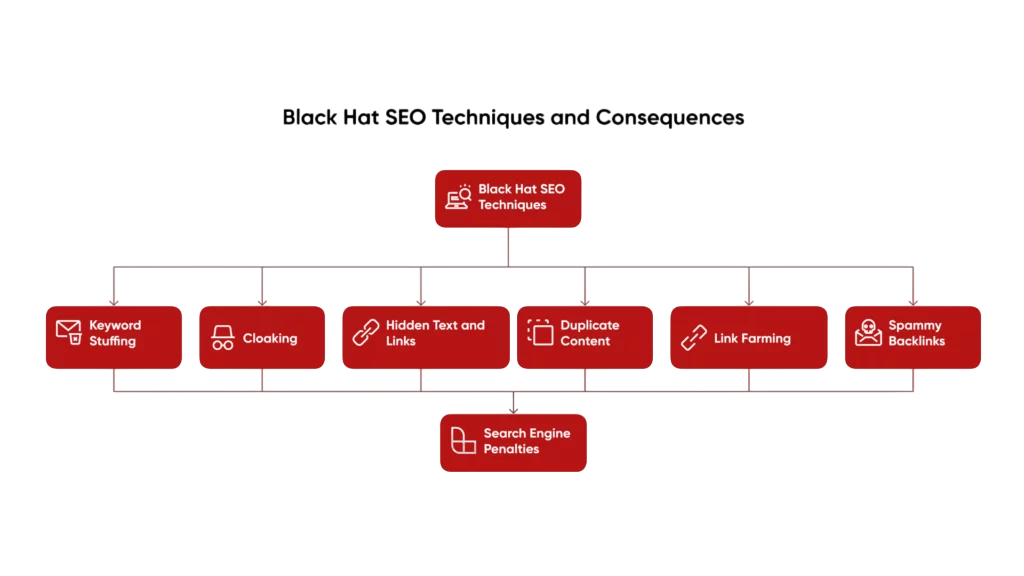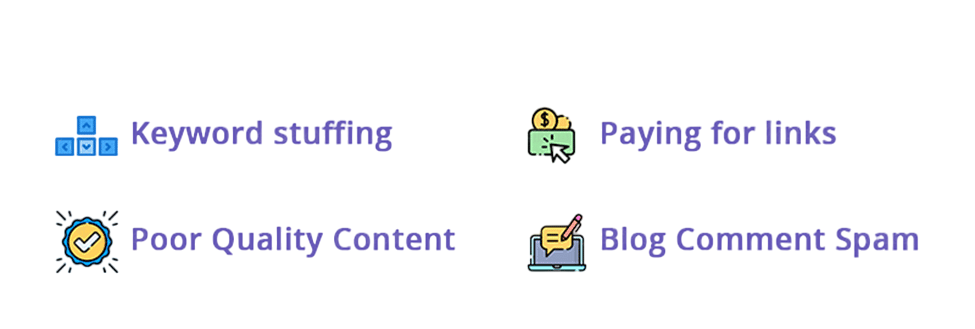
- Introduction
- Understanding SEO Basics
- What is Black Hat SEO?
- Common Black Hat SEO Techniques
- Why Do People Use Black Hat SEO?
- The Risks and Consequences of Black Hat SEO
- Real-Life Examples of Black Hat SEO Penalties
- Black Hat vs White Hat vs Gray Hat SEO
- Conclusion
Introduction
Search engine optimization (SEO) is the backbone of digital marketing. It determines whether your content reaches page one of Google or fades into internet obscurity. But while most marketers aim to follow ethical practices, some choose shortcuts to manipulate search engine rankings known as Black Hat SEO. In this guide, we’ll dive deep into what Black Hat SEO is, the tactics it involves, why some marketers still use it, and the serious consequences it can bring. Whether you’re a business owner, marketer, Digital Marketing Training or SEO beginner, understanding Black Hat SEO is critical to avoiding costly mistakes.Black Hat SEO refers to a set of unethical practices used to improve a website’s search engine ranking by violating search engine guidelines. These techniques prioritize quick results over long-term success and often involve manipulating algorithms rather than providing valuable content for users. Common black hat tactics include keyword stuffing (overloading a page with keywords), cloaking (showing different content to search engines and users), hidden text or links, and purchasing backlinks from low-quality or spammy websites. While these methods may temporarily boost rankings, they carry significant risks. Search engines like Google continuously update their algorithms to detect and penalize websites that use black hat SEO. Penalties can range from ranking drops to complete removal from search engine results pages, severely damaging a site’s visibility and credibility. Despite the potential short-term gains, black hat SEO is generally discouraged because it undermines the quality and integrity of search results. Instead, ethical or “white hat” SEO practices focus on creating valuable content, optimizing user experience, and earning backlinks naturally. Understanding black hat SEO is important for digital marketers so they can avoid harmful strategies that might lead to penalties and instead invest in sustainable techniques that build long-term online success.
Ready to Get Certified in Digital Marketing? Explore the Program Now Digital Marketing Online Training Offered By ACTE Right Now!
Understanding SEO Basics
SEO (Search Engine Optimization) improves a website’s visibility on search engines like Google.
- It helps drive organic (non-paid) traffic to your site.
- SEO is divided into three main areas:
- On-Page SEO – optimizing content, keywords, meta tags, headings, and internal links.
- Off-Page SEO – building backlinks and boosting domain authority through external signals.
- Technical SEO – improving site speed, mobile-friendliness, TensorFlow, crawlability, and site structure.
- Keywords are terms people search for; using them wisely helps your content rank.
- Search intent matters — you must match content to what users are truly looking for.
- Quality content is key — informative, relevant, and well-structured content performs better.
- User experience (UX) factors like page speed, mobile optimization, and navigation impact SEO.
- Search engines use algorithms to rank content based on relevance, authority, and usability.
- SEO is a long-term strategy, not a one-time task — it requires regular updates and monitoring.
- Keyword Stuffing: Keyword stuffing involves overusing keywords in content, meta tags, or alt text to manipulate rankings. For example: “If you need car insurance, our car insurance company offers the best car insurance for anyone needing car insurance.” It creates a poor user experience and is easily detected by search engines.
- Cloaking: Cloaking involves presenting different content to search engine crawlers than what users actually see. This tricks the algorithm into indexing a page for unrelated or misleading content. For example, a page might show “weight loss tips” to users but “download free movies” to search engines.
- Hidden Text and Links: This tactic hides content by making it the same color as the background, setting font size to zero, or positioning it off-screen. The goal is to load SEO-friendly text invisible to users. Google’s bots can detect this easily today and often penalize it harshly.
- Doorway Pages: These are low-quality pages stuffed with keywords, Digital Marketing Components designed solely to rank and funnel users to another page. They don’t provide real value and exist only to manipulate rankings. Example: Creating hundreds of pages with slight keyword variations like “buy shoes in Chicago,” “buy shoes in New York,” etc.
- Link Schemes: Link schemes are any attempts to manipulate PageRank or backlink profiles through unnatural linking. Examples include buying or selling backlinks, excessive link exchanges, using automated tools to generate backlinks, or creating fake sites solely for linking.
- Private Blog Networks (PBNs): A PBN is a group of websites built for the sole purpose of passing link juice to another site. These often use expired domains with authority to create an illusion of natural backlinks. Google has cracked down on PBNs multiple times, and their use is increasingly risky.
- Content Automation and Scraping: Instead of creating original content, Black Hat SEOs may use bots to scrape content from other websites or generate content using low-quality AI tools, Social Media Marketing Salary spinning them into articles. These articles are often unreadable and offer no value to users.
- Clickbait and Misleading Content: Creating sensational headlines to drive traffic (e.g., “You Won’t Believe What Happened Next”) without delivering relevant content is a form of manipulation that can backfire with high bounce rates and penalties.
- Search Engine Penalties – Google and other search engines may penalize your site, causing a major drop in rankings.
- De-indexing – In severe cases, your website can be completely removed from search engine results.
- Loss of Organic Traffic – Drops in rankings lead to lower visibility and reduced organic traffic.
- Damaged Reputation – Users and other websites may view your brand as untrustworthy or unethical.
- Wasted Time and Resources – Short-term gains can be quickly lost, wasting effort and budget.
- Poor User Experience – Tactics like keyword stuffing or cloaking can frustrate visitors Digital Marketing Metrics and drive them away.
- Difficult Recovery – Rebuilding trust with search engines after a penalty can take months or even years.
- Legal Risks – In rare cases, deceptive practices may lead to legal trouble, especially if false claims or copyright violations are involved.
- Short-Term Focus – Black hat tactics ignore long-term growth and sustainability, risking long-term failure.
- Negative Impact on Conversions – Traffic earned through spammy methods may not lead to quality leads or sales.
What is Black Hat SEO?
Black Hat SEO refers to unethical or manipulative tactics used to increase a website’s ranking in search engines. These practices violate search engine guidelines, particularly Google’s Webmaster Guidelines, Digital Marketing Metrics and are focused on short-term gains rather than sustainable growth. The term “black hat” comes from old Western films where villains often wore black hats to distinguish them from the heroes in white. Black Hat SEO aims to trick search engines instead of providing real value to users. While these tactics can sometimes deliver quick boosts in rankings, they come with high risk penalties, de-indexing, and long-term brand damage.Black Hat SEO refers to a collection of unethical or manipulative techniques used to improve a website’s ranking in search engine results by violating search engine guidelines.

These practices are designed to trick search algorithms rather than provide value to users. Common examples include keyword stuffing, cloaking (showing different content to users and search engines), using hidden text or links, and buying low-quality backlinks. While black hat methods can sometimes lead to quick boosts in search rankings, they carry serious risks. Websites that use black hat SEO may be penalized or completely removed from search engine indexes once the tactics are detected. These penalties can significantly damage a site’s visibility, credibility, and traffic. Because of this, black hat SEO is not recommended for businesses or content creators who are building long-term, sustainable online growth. Instead, ethical approaches known as white hat SEO focus on creating valuable content, following search engine rules, Types of Social Media and improving the user experience. Understanding black hat SEO is important so marketers and website owners can avoid shortcuts that may harm their site’s reputation and performance over time.
To Explore Digital Marketing in Depth, Check Out Our Comprehensive Digital Marketing Training To Gain Insights From Our Experts!
Common Black Hat SEO Techniques

Why Do People Use Black Hat SEO?
Despite the risks, Black Hat SEO remains tempting for some because of quick results, competitive pressure, lack of knowledge, or client demands. Black Hat tactics can temporarily improve rankings and traffic. In highly competitive industries, some feel pressured to bend the rules. Sometimes, marketers may use these tactics unknowingly. Agencies may also feel pushed to deliver short-term ROI quickly. However, Digital Marketing Training what works briefly can lead to long-term damage.People use Black Hat SEO because it can offer fast, short-term results in boosting a website’s ranking and visibility. For some, especially in highly competitive industries or for low-quality websites, black hat tactics can seem like a shortcut to getting more traffic, leads, or sales without putting in the time to build content or earn links organically. These methods often require less effort than white hat SEO strategies and may deliver quick wins such as appearing on the first page of search results before search engines detect the manipulation. Additionally, some individuals may lack proper SEO knowledge or intentionally take risks, especially if they’re working on disposable or temporary websites. In other cases, businesses under pressure to deliver fast results may turn to unethical agencies or tactics without fully understanding the long-term consequences. However, while black hat SEO may seem tempting, it’s important to remember that it comes with serious risks like search engine penalties, ranking drops, or even being banned entirely from search results. That’s why ethical Search Engine Optimization practices are the smarter, safer path for long-term online success.
Looking to Master Digital Marketing? Discover the Digital Marketing Expert Masters Program Training Course Available at ACTE Now!
The Risks and Consequences of Black Hat SEO
Real-Life Examples of Black Hat SEO Penalties
BMW (2006) used doorway pages to rank for “used cars.” Google penalized them by removing the site from its index temporarily. JC Penney (2011) was caught buying backlinks. Google manually penalized the site, Black Hat SEO Penalties, causing a major rankings drop during the holiday season. Rap Genius (Now Genius.com) was penalized for link schemes and had to publicly apologize and fix all violations before regaining rankings. These cases show even major brands are not immune.Several well-known websites have faced serious penalties due to Black Hat SEO practices, Digital Marketing Certification Process showing how risky and damaging these tactics can be. One of the most famous cases involved BMW Germany, which was penalized by Google in 2006 for using doorway pages low-quality pages stuffed with keywords that redirected users to other content. As a result, BMW’s site was temporarily removed from Google’s index. Another example is JCPenney, a major U.S. retailer that suffered a ranking drop in 2011 after being caught using thousands of paid backlinks to manipulate search rankings during the holiday season. Google responded by manually penalizing the site, causing its search visibility to plummet. Rap Genius (now Genius.com), a lyrics website, was also penalized in 2013 for engaging in link schemes by encouraging bloggers to link back to their site in exchange for promotion. These cases highlight how even large, established brands are not immune to search engine penalties when they engage in deceptive SEO tactics. The long-term impact of such penalties often includes a significant loss of traffic, revenue, and reputation, reinforcing the importance of following ethical, white hat SEO strategies.
Black Hat vs White Hat vs Gray Hat SEO
| Type | Definition | Risk Level | Examples |
|---|---|---|---|
| White Hat | Ethical SEO following search guidelines | Low | Content marketing, on-page optimization |
| Gray Hat | Borderline tactics not explicitly forbidden | Moderate | Expired domain redirects, Market Research aggressive outreach |
| Black Hat | Manipulative, violates guidelines | High | Cloaking, link schemes, keyword stuffing |
Preparing for Digital Marketing Job Interviews? Have a Look at Our Blog on Digital Marketing Interview Questions and Answers To Ace Your Interview!
Conclusion
Black Hat SEO may seem like a shortcut to success, but it’s a risky gamble that can damage your website’s reputation and ranking in the long run. Ethical SEO, focused on quality content and genuine user engagement, remains the best way to build sustainable online presence. Understanding the differences between Black Hat, Gray Hat, and White Hat techniques helps you make informed decisions that protect your brand and grow your business effectively in 2025 and beyond.In conclusion, Black Hat SEO may offer fast results, but the risks far outweigh the short-term benefits. Using unethical tactics like keyword stuffing, cloaking, or buying backlinks can lead to severe penalties, including ranking drops, de-indexing, and long-term damage to your website’s credibility and visibility. Real-life cases show that even major brands have suffered from taking shortcuts. For sustainable growth and lasting online success, it’s essential to follow search engine guidelines, focus on creating valuable content, Digital Marketing Training and invest in ethical (white hat) SEO strategies. Understanding the dangers of black hat SEO helps you make smarter decisions and build a trustworthy presence in the digital world.




